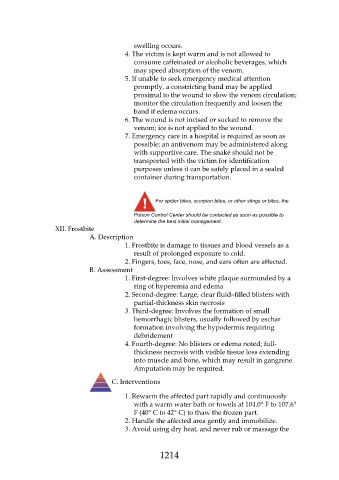Page 1214 - Saunders Comprehensive Review For NCLEX-RN
P. 1214
swelling occurs.
4. The victim is kept warm and is not allowed to
consume caffeinated or alcoholic beverages, which
may speed absorption of the venom.
5. If unable to seek emergency medical attention
promptly, a constricting band may be applied
proximal to the wound to slow the venom circulation;
monitor the circulation frequently and loosen the
band if edema occurs.
6. The wound is not incised or sucked to remove the
venom; ice is not applied to the wound.
7. Emergency care in a hospital is required as soon as
possible; an antivenom may be administered along
with supportive care. The snake should not be
transported with the victim for identification
purposes unless it can be safely placed in a sealed
container during transportation.
For spider bites, scorpion bites, or other stings or bites, the
Poison Control Center should be contacted as soon as possible to
determine the best initial management.
XII. Frostbite
A. Description
1. Frostbite is damage to tissues and blood vessels as a
result of prolonged exposure to cold.
2. Fingers, toes, face, nose, and ears often are affected.
B. Assessment
1. First-degree: Involves white plaque surrounded by a
ring of hyperemia and edema
2. Second-degree: Large, clear fluid–filled blisters with
partial-thickness skin necrosis
3. Third-degree: Involves the formation of small
hemorrhagic blisters, usually followed by eschar
formation involving the hypodermis requiring
debridement
4. Fourth-degree: No blisters or edema noted; full-
thickness necrosis with visible tissue loss extending
into muscle and bone, which may result in gangrene.
Amputation may be required.
C. Interventions
1. Rewarm the affected part rapidly and continuously
with a warm water bath or towels at 104.0° F to 107.6°
F (40° C to 42° C) to thaw the frozen part.
2. Handle the affected area gently and immobilize.
3. Avoid using dry heat, and never rub or massage the
1214

